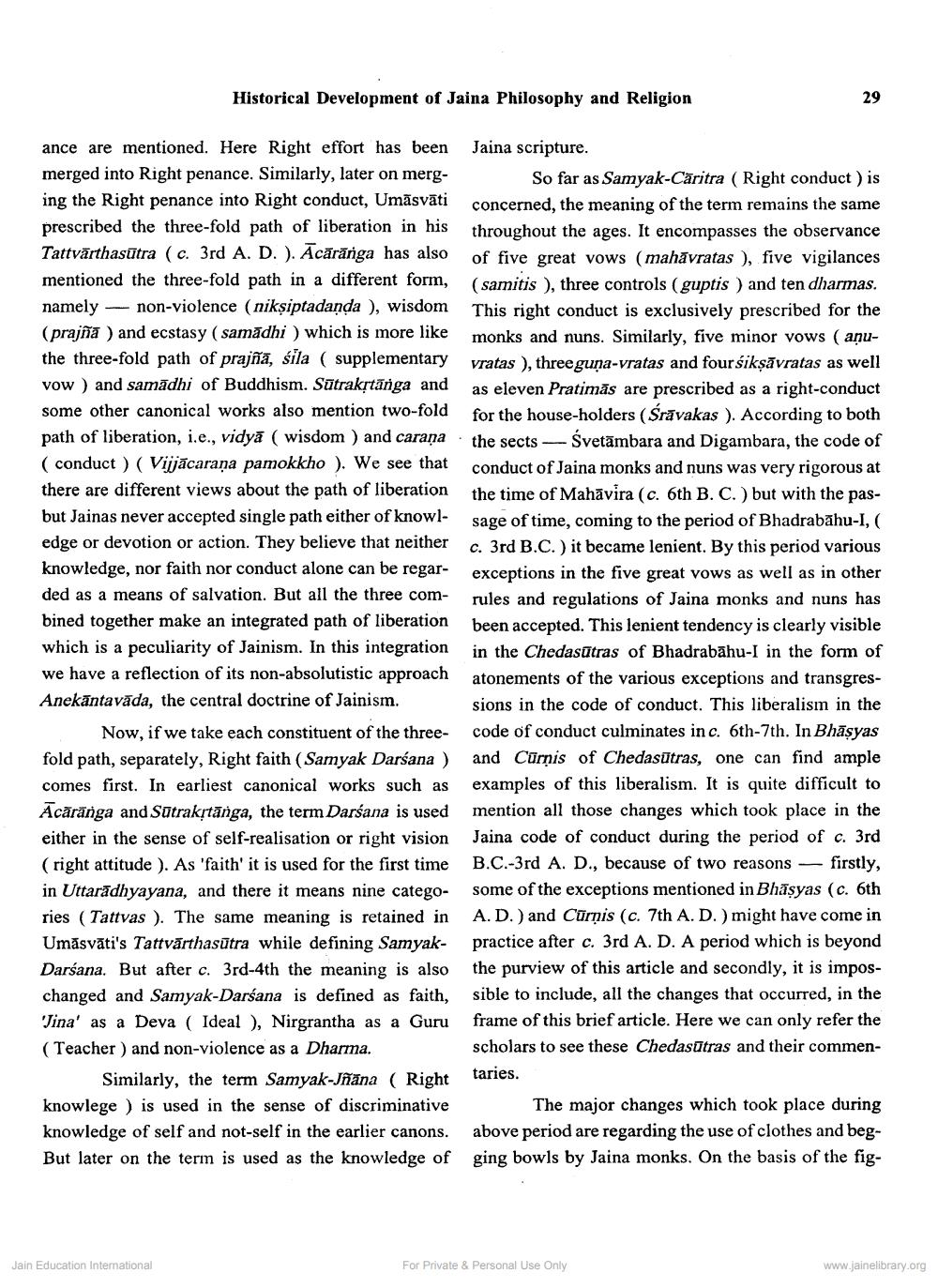Book Title: Historical Development of Jaina Philosophy and Religious Author(s): Sagarmal Jain Publisher: Z_Shwetambar_Sthanakvasi_Jain_Sabha_Hirak_Jayanti_Granth_012052.pdf View full book textPage 8
________________ Historical Development of Jaina Philosophy and Religion Jaina scripture. So far as Samyak-Caritra (Right conduct) is concerned, the meaning of the term remains the same throughout the ages. It encompasses the observance of five great vows (mahāvratas), five vigilances (samitis), three controls (guptis) and ten dharmas. This right conduct is exclusively prescribed for the monks and nuns. Similarly, five minor vows (aņuvratas), three guna-vratas and four sikṣāvratas as well as eleven Pratimas are prescribed as a right-conduct for the house-holders (Śravakas). According to both the sectsŚvetambara and Digambara, the code of conduct of Jaina monks and nuns was very rigorous at the time of Mahavira (c. 6th B. C.) but with the passage of time, coming to the period of Bhadrabahu-I, ( c. 3rd B.C.) it became lenient. By this period various exceptions in the five great vows as well as in other rules and regulations of Jaina monks and nuns has been accepted. This lenient tendency is clearly visible in the Chedasutras of Bhadrabahu-I in the form of atonements of the various exceptions and transgressions in the code of conduct. This liberalism in the code of conduct culminates in c. 6th-7th. In Bhāṣyas and Curnis of Chedasūtras, one can find ample examples of this liberalism. It is quite difficult to mention all those changes which took place in the Jaina code of conduct during the period of c. 3rd B.C.-3rd A. D., because of two reasons firstly, some of the exceptions mentioned in Bhāṣyas (c. 6th A. D.) and Curnis (c. 7th A. D.) might have come in practice after c. 3rd A. D. A period which is beyond the purview of this article and secondly, it is impossible to include, all the changes that occurred, in the frame of this brief article. Here we can only refer the scholars to see these Chedasūtras and their commentaries. ance are mentioned. Here Right effort has been merged into Right penance. Similarly, later on merging the Right penance into Right conduct, Umasvati prescribed the three-fold path of liberation in his Tattvärthasūtra (c. 3rd A. D. ). Acaranga has also mentioned the three-fold path in a different form, namely non-violence (nikṣiptadanda), wisdom (prajña) and ecstasy (samadhi) which is more like the three-fold path of prajñā, sila (supplementary vow) and samadhi of Buddhism. Sūtrakṛtānga and some other canonical works also mention two-fold path of liberation, i.e., vidya ( wisdom) and caraṇa (conduct) (Vijjacaraṇa pamokkho ). We see that there are different views about the path of liberation but Jainas never accepted single path either of knowledge or devotion or action. They believe that neither knowledge, nor faith nor conduct alone can be regarded as a means of salvation. But all the three com bined together make an integrated path of liberation which is a peculiarity of Jainism. In this integration we have a reflection of its non-absolutistic approach Anekantavāda, the central doctrine of Jainism. Now, if we take each constituent of the threefold path, separately, Right faith (Samyak Darśana) comes first. In earliest canonical works such as Acārānga and Sūtrakṛtānga, the term Darśana is used either in the sense of self-realisation or right vision (right attitude). As 'faith' it is used for the first time in Uttaradhyayana, and there it means nine categories (Tattvas). The same meaning is retained in Umāsvāti's Tattvarthasūtra while defining SamyakDarśana. But after c. 3rd-4th the meaning is also changed and Samyak-Darśana is defined as faith, 'Jina' as a Deva ( Ideal), Nirgrantha as a Guru (Teacher) and non-violence as a Dharma. Similarly, the term Samyak-Jñana (Right knowlege) is used in the sense of discriminative knowledge of self and not-self in the earlier canons. But later on the term is used as the knowledge of Jain Education International 29 - For Private & Personal Use Only The major changes which took place during above period are regarding the use of clothes and begging bowls by Jaina monks. On the basis of the fig www.jainelibrary.orgPage Navigation
1 ... 6 7 8 9 10 11 12 13
